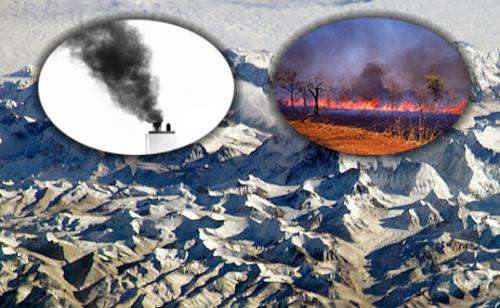A new way to quantify and track soot from its source to destination

No one wants to see dirty snow. But that's just what appears when soot—from forest fires, diesel engines, and other fuel combustion—hitchhikes to the Arctic on atmospheric currents. Researchers at Pacific Northwest National Laboratory designed a new way to identify and track the sources of soot using an atmospheric model and a tagging technique that is both efficient and effective. The result establishes a clear source-receptor relationship and soot pathways that will help explain the seasonal variations found for soot deposition. This finding will contribute to insights on the impact of darkened snow and ice on the Earth's energy budget.
"Our approach addressed the scientific problem in a new way that is systematic, comprehensive, and computationally efficient," said Dr. Hailong Wang, an atmospheric scientist who led the team work. "And, the new technique enables us to quantify the global impact of black carbon—a.k.a. soot—originating from many different regions and source types."
The Arctic is warming at almost twice the rate of the globally averaged surface temperature. Many believe that the region's rate of ice and snow melt is a bellwether for global climate warming. The resulting rise in sea level will impact fishing, shipping, coastlines, human, animal and plant communities in the Arctic. Soot particles found in the Arctic—most of them originating from other areas—are believed to play a prominent role in that warming. To better understand how the Arctic climate responds to changing levels of soot and the effectiveness of possible mitigation efforts to reduce warming, it is necessary to accurately identify the sources and quantities of soot from each world region. To tackle the scientific problems for these questions, the team developed an approach that is very efficient and more powerful than alternate methods. The same tool can be used to quantify how much soot travels from major source regions to other regions of interest, for instance, the western United States and the Tibetan Plateau in China.
The PNNL research team implemented, for the first time, an explicit source tagging technique to quantify sources of black carbon (BC) that reaches destinations (receptor regions), especially the Arctic. The researchers used a global aerosol-climate model called the Community Atmosphere Model version 5 (CAM5) and constrained the simulations to better agree with observed meteorology for the 1995-2005 period. The team was able to take advantage of another recent PNNL study that modified CAM5 aerosol-cloud representations to improve the fidelity of aerosol simulations for the Arctic. The BC source tagging technique they developed allowed relationships between BC sources and BC reaching the Arctic to be derived without actually perturbing emissions, as is often done in similar studies. The much higher computational efficiency makes the technique useful for exploring source-receptor relationships in computationally demanding high-resolution global simulations with many source regions or source types.
The tagging technique allowed identification of the amount of BC in the air and the amount deposited to the snow and ice surface that originates in different source regions. The study identified source regions most important to the Arctic, which differ in summer and winter. It also quantified the impact of BC originating from different source regions on the global atmospheric energy budget, and how these estimates vary from one year to another due to changes in winds and precipitation.
As part of the project, this new modeling tool is also being used to explore sources and impact of soot in snow and ice over the Himalayas and Tibetan Plateau, where soot may accelerate glacier and snowpack melting. They are also running high-resolution simulations to explore how changes in emissions affect future climate.
More information: Wang H, PJ Rasch, RC Easter, B Singh, R Zhang, PL Ma, Y Qian, SJ Ghan, and N Beagley. 2014. "Using an Explicit Emission Tagging Method in Global Modeling of Source-Receptor Relationships for Black Carbon in the Arctic: Variations, Sources, and Transport Pathways." Journal of Geophysical Research: Atmospheres 119:12,888-12,909. DOI: 10.1002/2014JD022297
Journal information: Journal of Geophysical Research - Atmospheres
Provided by Pacific Northwest National Laboratory



















